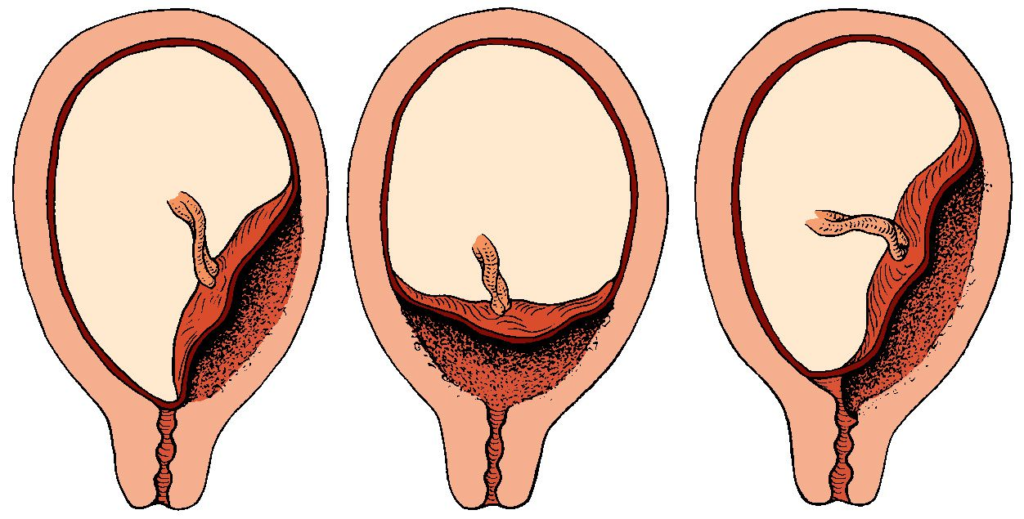Placenta previa is a pregnancy condition characterized by the placenta partially or wholly covering the cervix, which is the outlet of the uterus. This condition can pose significant risks during pregnancy and delivery, necessitating careful monitoring and management. In this blog, we’ll delve into the intricacies of placenta previa, including its types, causes, symptoms, diagnosis, treatment options, and the potential impact on pregnancy and childbirth.
What is Placenta Previa?
It occurs when the placenta implants itself in the lower part of the uterus and covers the cervix either partially or completely. The cervix is the passage through which the baby exits the uterus during birth. The condition is most commonly diagnosed through ultrasound in the second or third trimester of pregnancy.

Types of Placenta Previa
There are several types of placenta previa, classified based on the placenta’s location and degree of cervical coverage:
Complete Placenta Previa: The placenta entirely covers the cervical opening.
Partial Placenta Previa: The placenta covers a portion of the cervical opening.
Marginal Placenta Previa: The placenta is at the edge of the cervix but does not cover the opening.
Low-Lying Placenta: The placenta is located in the lower uterus but does not reach the cervix.
Causes and Risk Factors
The exact cause of placenta previa is unknown, but several factors may increase the risk:
- History of placenta previa in a previous pregnancy
- Previous cesarean section (C-section) or surgical procedure on the uterus
- Multiple pregnancies (twins, triplets, etc.)
- Being over the age of 35
- Smoking and cocaine use during pregnancy

Symptoms
The primary symptom of placenta previa is painless, bright red bleeding from the vagina in the second or third trimester. Some women may experience contractions along with the bleeding. It’s crucial to seek immediate medical attention if these symptoms occur.
Diagnosis
It is typically diagnosed through an ultrasound examination, which can determine the placenta’s location in relation to the cervix. If diagnosed, further ultrasounds will likely be scheduled to monitor the condition and its impact on the pregnancy.
Treatment and Management
The treatment for placenta previa depends on several factors, including the amount of bleeding, the pregnancy’s gestational age, and the baby’s health. Management strategies include:
- Expectant management: In cases of minimal bleeding, doctors may recommend rest and monitoring to allow the pregnancy to progress as long as possible.
- Medical treatment: If bleeding is significant, hospitalization and medical interventions, such as blood transfusions, may be necessary.
- Delivery: A C-section is often recommended for delivery, especially in cases of complete or partial placenta previa, to avoid the risks associated with vaginal delivery.
Impact on Pregnancy and Childbirth
It can complicate pregnancy and delivery, increasing the risk for preterm birth, blood loss during delivery, and the need for a C-section. With careful monitoring and appropriate medical care, however, many women with placenta previa can successfully deliver healthy babies.

Conclusion
It is a serious pregnancy condition that requires careful management and monitoring. Understanding the types, causes, symptoms, and treatment options can help expectant mothers and their families navigate the challenges it presents. With the right care, the risks associated with it can be significantly reduced, leading to safe and successful outcomes for both mother and child.
Our Doctors
Dedicated IR Center for Vascular Problems in Madhya Pradesh
DR. SHAILESH GUPTA
MD, PDCC (INTERVENTIONAL RADIOLOGY) Consultant & Co-Director CVIC (Center Of Vascular & Interventional Care)
DR. ALOK KUMAR UDIYA
MD Radiology, PDCC (Neurointervention Radiology), PDCC ( HPB Intervention Radiology) FINR (Switzerland) & EBIR
Endovascular Surgeon & Consultant Interventional Neuroradiologist at Care CHL Hospital, Indore Co-director CVIC( center for vascular and interventional care)https://interventionradiologyindore.com/
DR. NISHANT BHARGAVA
Consultant Intervention Radiologist
MD Radiology, PDCC ( Neurointervention Radiology), FINR ( Fellowship in Neurointervention Radiology)
Co-director CVIC(Center for Vascular and Interventional Care)
Contact Details
Phone no.
0731 4675670
+91 9827760073
Facebook
https://www.facebook.com/profile.php?id=100092538633553&mibextid=ZbWKwL
Instagram
https://instagram.com/cvic_center?igshid=ZGUzMzM3NWJiOQ==
Google My business
https://g.co/kgs/DrdV3T
YouTube
https://www.youtube.com/channel/UCP5TH5e4iQZkpDUgnLsgZhw
Pinterest
https://pin.it/5DzpX5Z
Twitter
https://x.com/cviccenter?t=01TclSrLFdu0K2re0Gs96w&s=08
LINKEDIN
https://www.linkedin.com/company/center-of-vascular-interventional-care/
Location
Read More –
Intracranial Stenting in Neuro Intervention – https://cvicvascular.com/intracranial-stenting-in-neuro-intervention/
Mechanical Thrombectomy for acute stroke in Neuro Intervention – https://cvicvascular.com/mechanical-thrombectomy-for-acute-stroke-in-neuro-intervention/
Spinal AVM Embolisation in Neuro Intervention – https://cvicvascular.com/spinal-avm-embolisation-in-neuro-intervention/







